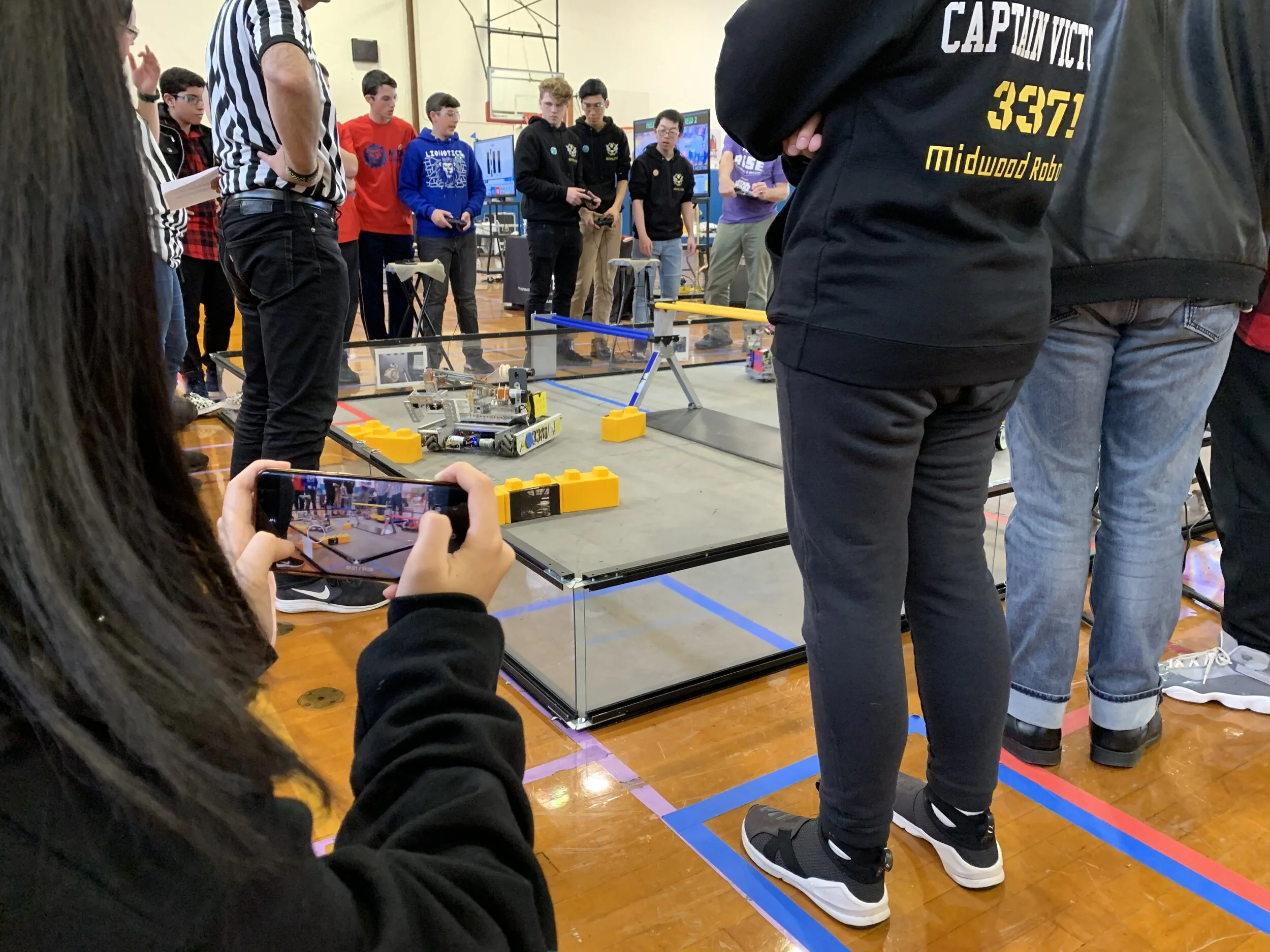Robotics Teams Shake Off the Rust in First Qualifier
Bötley Crüe stands in the blue alliance square, working on a strategy for the match. Photo Credit: Tracy Lam
By NICHOLAS MORGAN, TRACY LAM, and DARNAILIA HOLMES
“Park! Park! Park!” was all you could hear as the crowd cheered. It was the final 30 seconds of the match, and the teams were frantically trying to move the foundations out of their building sites to park their robots in their places.
This was the scene at John Dewey High School on Sunday, December 8, where Midwood’s three robotics teams competed in the league’s first qualifiers.
Of the three teams, Bötley Crüe ranked 16th, the Rolling Drones 21st, and Pink Droyd 30th. It was their first actual robotics competition this year, and while the teams didn’t place high enough to advance, they will have another shot at qualifying on January 12 at Francis Lewis High School in Queens.
In this First Tech Challenge, called “SkyStone,” there were two teams that each had two robots and a red and blue platform. The objective was to have their robots build skyscrapers with the blocks provided. Putting smaller blocks called “capstones” on top added more points.
The first 30 seconds of the match were autonomous, in which the robot had to do everything as pre-programmed. After that, the teams could use controllers to move the robots. There were blocks, called “stones,” and the teams were to place the stones on the foundation and hopefully be able to stack the stones to create a tower.
Within the last 30 seconds, if the teams were able to park their robots in the building site, they would be rewarded with five extra points. These five points were essential as they could easily make the difference between a win and a loss.
Prior to taking AutoCAD, the robotics team students only had one to two years of experience with similar robots. Even with these years of experience, it was a different feeling competing at the meet, team members said.
The matches began around 11 a.m., and the teams had to arrive there around 8 a.m. to check if their robots met the requirements for dimensions and materials. All three teams passed the check.
The robots are made using channel beams comprised of aluminum and other metals. This material makes them “durable, reusable, and reliable,” Daniel Musheev ’20 said.
The channel beams come in many sizes, which gave the teams more flexibility while building the robots. The teams were also allowed to use power tools to modify pieces to fit their needs.
Bötley Crüe members Gavin Xiao ’21 and Joanna Zheng ’20 make some last minute repairs before the matches begin. Photo Credit: Tiffany Pan
Although the teams had creative control over the robot and how to design it, they still had some restrictions implemented by FIRST, a worldwide not-for-profit STEM engagement program. Their robots had to fit the requirement of being 18 inches wide by 18 inches long by 18 inches high. However, the robot could have parts that extended, making it easier for it to stack the “stones.”
The team members were able to design a robot that everyone was somewhat satisfied with, but an early supply shortage created a disadvantage.
“It took a long time to order things,” said Ms. Lisa Ali, the team’s coach and AutoCAD teacher. “We ordered in October, which took two months away from the building process.” In the meantime, the teams got creative and 3D printed some of their supplies.
During one of the 42 matches, another team in an alliance with Bötley Crüe found the battery that powered their robot was dead. There was a moment of panic, and the other team members from Bötley Crüe offered the ally their spare battery, only to be told that the battery wasn’t the same as the one they used. Thankfully, there was still over a minute left of the other match going on in another field and the team was able to get a battery in time for the match to start.
The teams dealt with some technical issues. “A lot of the problem was the phone [controlling the robot],” said Shayan Ali ’20, the captain of the Rolling Drones. “If you touched the controller, you got punished.”
To program the robot, members use controllers and software called Java. The robot and the controller must be connected to individual phones. The Rolling Drones had to touch the controller and the phone more than once, which cost them points. Despite the stress they were under, they managed to stay calm. “We made light of the situation,” said Steven Louijean ’20.
Such challenges are what keeps robotics interesting, students said.
“At first I didn’t want to take the pre-engineering platform, but I ended up liking it,” said Joanna Zheng ’20. “I was intrigued by complicated codes.”
The teams are now working on improving their robots by building a chassis — the base frame — for the next competition.
Victoria Krauze ’20, captain of Bötley Crüe, said, “I have faith that we’ll do better in the next one and make it in the top ten and even get an award.” All of the teams are working hard to refine their robots.
The last opportunity to qualify is January 12. If they win, they get to move on to the super qualifier at Dayton High School.
But the teams’ efforts are not only about competing, they said. As a team, they have been together for years, so supporting and improving together is also a priority.
“I love mentoring the teams because I had them since they were sophomores,” said Ms. Ali. “I like to see them now, thinking strategically and bringing wild ideas to life.”


